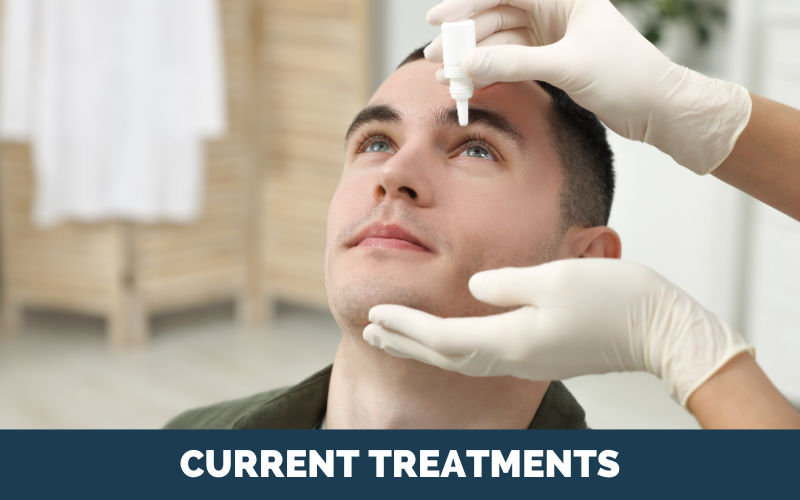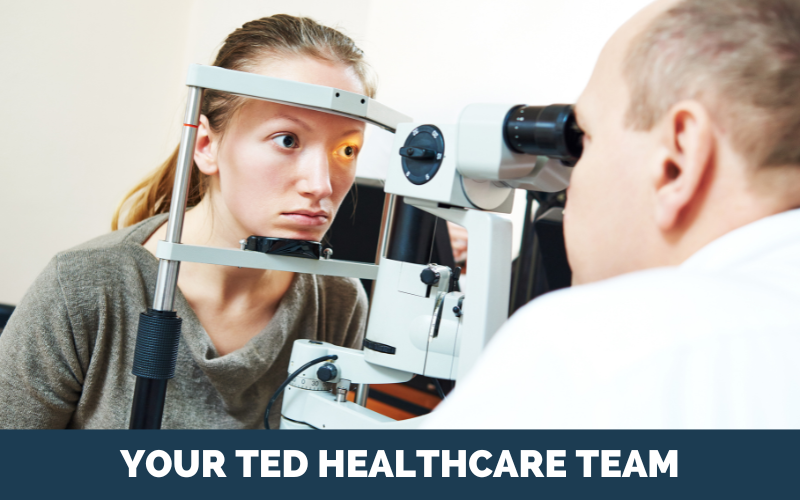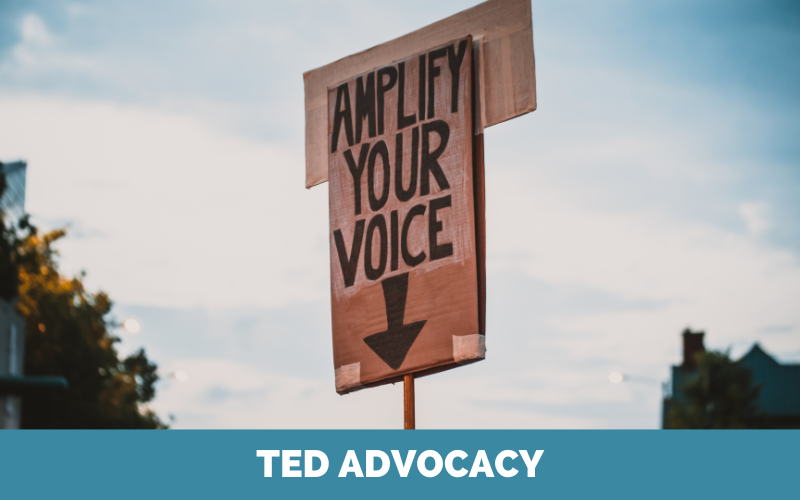Thyroid Eye Disease
Living with thyroid eye disease
Self-management, mental health and tips for living well
Having new or strange health symptoms can be very scary, especially when they affect how you look or how your body works. That’s why it’s completely normal to feel anxious after receiving a diagnosis of thyroid eye disease (TED). The good news is that there are treatments available for TED at any stage, and there are people and resources available to help you cope with the physical and emotional challenges that come with it.
Most people with TED also live with an autoimmune thyroid condition like Graves’ disease (overactive thyroid) or Hashimoto’s disease (underactive thyroid). They might already be managing symptoms like fatigue or sudden mood swings, which can often be controlled with hormone treatments.
However, some people with TED don’t have a thyroid condition when they are diagnosed. In some cases, they may develop one later, but others won’t. It’s also possible that you may not connect your eye symptoms with any other health issues at all.
Common symptoms of TED include:
- Bulging eyes
- Eye pain or eye pressure
- Retracted eyelids
- Dry, gritty eyes
- Watery, teary eyes
- Puffy eyes or eyelids
- Inflamed eyelids
- Red eyes or eyelids or bloodshot eyes
- Light sensitivity
- Blurry or double vision
- Misaligned or crossed eyes (causing double vision)
- Vision loss
These symptoms may already be affecting your life. For example, you may feel self-conscious and avoid being around others, especially if you’re worried that you’re contagious or if you’re in (or seeking) a close personal relationship. You might also struggle with reading, watching TV, cooking or driving, which can lead to feelings of depression because you’re unable to do the things you enjoy.
Many people try to manage their symptoms on their own with over-the-counter treatments, hoping they will go away. While these medications can help relieve your symptoms, they won’t stop your symptoms from progressing. Therefore, it is important to see a relevant health professional as soon as possible to reduce the risk of lasting eye or vision impairment. This could be your GP or endocrinologist or an optometrist, ophthalmologist or rheumatologist.
To help your healthcare provider help you, it is a good idea to start tracking your symptoms and sharing that information with them. You could note which symptoms appeared first, what triggers them, what seems to help, and any other patterns you notice that might be important.
When you talk to your doctor, make sure they take your concerns seriously and don’t dismiss you. If you feel like your concerns are not being addressed, bring a friend or family member with you to your appointments, or don’t hesitate to seek a second opinion. If you have TED, speaking up and advocating for your health and wellbeing can help you better manage your condition and live a healthier life.
Always remind yourself that your condition does not define who you are. By now, you’ve learned that there are a variety of treatment options for different stages of TED. Now, let’s focus on how you can best handle the daily lifestyle changes that may come up while you’re being treated.
Here are some key tips to remember when thinking about your treatments:
- Most people don’t progress beyond the mild to moderate stages of TED.
- Don’t expect instant results from all your treatments; some may take weeks or months to be fully effective.
- Don’t compare progression with others; we all experience symptoms and process medications differently. For example, an oral treatment that works wonders for you might not have any effect on someone else.
- Work with your doctors to develop a treatment plan that’s right for you. The plan should include the first steps you’ll take together and what to expect as your treatment progresses. Don’t hesitate to ask lots of questions and keep until you understand the answers.
- If you’re worried about the side effects of your treatments, discuss them with your healthcare team. Together, you can weigh up the risks and benefits and discuss how to manage any potential side effects if they come up.
Dealing with a chronic condition like TED can be very challenging. Your diagnosis may come as a surprise and the symptoms and treatments can be very frustrating, disappointing and even overwhelming. You may also feel embarrassed about changes in your appearance or anxious about your situation overall. It’s natural to grieve for the life you had before or wonder, “Why is this happening to me?”
Rest assured, it’s normal to feel this way, and it’s okay to move through stages of different emotions as you adjust to your “new normal” of living with TED. Keep in mind that help is available, and you can learn to live well with your condition.
Starting the conversation
Sometimes, it may seem like there’s not enough time to discuss your mental health during a medical appointment. But if your doctor doesn’t ask — and you’re concerned that you might be experiencing signs of depression or anxiety — don’t hesitate to bring it up yourself.
Your doctor needs to know how you’re feeling to treat you properly and to determine if your concerns are part of the condition or need to be addressed separately. They should have a full picture of who you are, not just your physical symptoms.
At your next GP or specialist visit, try one of the following conversation starters to spark a dialogue about your mental health:
- Can we talk about my mental health during this visit?
- I’m having trouble sleeping and I can’t focus — are these signs of anxiety or depression?
- I’m having strong mood swings — is there something we can do about that?
- I’m feeling a little down lately and have no interest in things — how do I know if I’m depressed?
- I’m finding the process of applying or taking my treatments and attending my doctors’ appointments tedious and I’m not sure if they’re even helping me — is that normal?
- I’m embarrassed to appear in public, but still want to socialise — what can I do?
- What diet or lifestyle modifications can I try to minimise depression/anxiety?
- Are there any medications or treatments that will help my depression/anxiety?
- Do you think I’d benefit from talking to a mental health professional?Dealing with a chronic condition like TED can be very challenging. Your diagnosis may come as a surprise and the symptoms and treatments can be very frustrating, disappointing and even overwhelming. You may also feel embarrassed about changes in your appearance or anxious about your situation overall. It’s natural to grieve for the life you had before or wonder, “Why is this happening to me?”Rest assured, it’s normal to feel this way, and it’s okay to move through stages of different emotions as you adjust to your “new normal” of living with TED. Keep in mind that help is available, and you can learn to live well with your condition.
Starting the conversation
Sometimes, it may seem like there’s not enough time to discuss your mental health during a medical appointment. But if your doctor doesn’t ask — and you’re concerned that you might be experiencing signs of depression or anxiety — don’t hesitate to bring it up yourself.
Your doctor needs to know how you’re feeling to treat you properly and to determine if your concerns are part of the condition or need to be addressed separately. They should have a full picture of who you are, not just your physical symptoms.
At your next GP or specialist visit, try one of the following conversation starters to spark a dialogue about your mental health:
- Can we talk about my mental health during this visit?
- I’m having trouble sleeping and I can’t focus — are these signs of anxiety or depression?
- I’m having strong mood swings — is there something we can do about that?
- I’m feeling a little down lately and have no interest in things — how do I know if I’m depressed?
- I’m finding the process of applying or taking my treatments and attending my doctors’ appointments tedious and I’m not sure if they’re even helping me — is that normal?
- I’m embarrassed to appear in public, but still want to socialise — what can I do?
- What diet or lifestyle modifications can I try to minimise depression/anxiety?
- Are there any medications or treatments that will help my depression/anxiety?
- Do you think I’d benefit from talking to a mental health professional?
Mental health professionals
There’s no shame in seeking mental health support. It’s just like seeing a doctor or physiotherapist for your physical health, and it helps you receive care on a more holistic level.
The benefits include:
- Reduced stress and anxiety
- Improved coping skills and strategies
- Increased self-esteem
- Better adherence to treatment
- Improved confidence, including when talking with health professionals
- Improved relationships
- Greater sense of control
Many of these goals can be reached through talking therapies, such as cognitive behavioural therapy (CBT). You might also benefit from using anti-anxiety or antidepressant medication. The right medication for you will depend on factors like the severity of your condition and whether you have other health conditions or take other medications.
Your GP can refer you to a psychologist, psychiatrist, counsellor or another allied mental health professional via a GP Mental Health Treatment Plan. In most cases, Medicare benefits are available for up to 10 appointments per patient per calendar year. The Beyond Blue website has information on what different mental health professionals do and how to find mental health services near you.
Support groups
Many people with chronic health conditions find that joining a support group (in-person or online) can be very helpful. Connecting with people who can relate to what you are going through can provide relief and comfort. These groups can often share valuable practical tips that your healthcare team might not think of or might not have time to share with you.
Support groups may be run by disease-specific health organisations, community health centres or neighbourhood houses. Peer support groups are run by people with the condition or the people around them, such as parents of children with a health condition.
Support groups are not “one size fits all,” so take your time exploring your options. Contact groups that interest you and ask how they are run. You can also attend a few meetings to see if they’re a good fit for you. For online groups, spend time observing the types of posts and comments that come up for a while before deciding if you want to participate in discussions.
Currently, there are no professionally organised support groups specifically for people with TED in Australia. While some informal private groups may exist online, they could be global or their approach may not suit you. If you would like our help to find and connect with others with TED, contact us at [email protected] and we can provide tips and support to get you started.
Ongoing stress can contribute to the development of many chronic health conditions. For those with autoimmune conditions, stress can trigger symptom flares and increase fatigue. Learning strategies to manage stress helps you take control of your well-being and improves your outlook, which is also important for your overall healing.
Adrian Comensoli, a registered psychologist based in Wollongong, Australia, shares the following tips for proactively managing your stress and improving your mental health.
- Listen to your body. Know your signs of too much stress. For example, not exercising or eating well, having difficulty concentrating, experiencing mood swings or feeling a sense of losing control.
- Accept your stress for what it is. Remind yourself that living with a chronic condition means you will have good and bad days, so try not to feel bad about what you “should” be doing.
- Rate your stress levels. Adrian suggests using a scale of one to 10 or traffic light colours.
- Have different strategies ready for different levels of stress, such as the ones below.
- Limit or amend your activities in times of high stress. Multi-tasking can increase stress levels so only focus on the most essential tasks at hand. Anything else can wait.
- Deliberately slow your breathing down if your breaths are shallow or your heart is pumping rapidly. Breathe deeply into your belly and exhale as slowly as possible.
- Release a build-up of nervous energy by doing some stretches or going for a walk.
- Slow down your racing thoughts by closing your eyes and listening to the sounds around you. Name three sounds you can hear. Acknowledge them but don’t assign any importance to them. Accept them as they are.
- Have a nap. The trick is to schedule your rest time, just like you would any other appointment. That way you will be less tempted to push through or forget about it.
When your stress is connected to internal sources such as pain or flares, use strategies that soothe and calm your body. If these don’t help, then you may need to draw on your other strategies such as taking medications or seeking support.
Lifestyle tips
To help manage your TED symptoms, consider the following tips:
- Quit or cut down on smoking: Smoking can make your TED symptoms worse, so it is a good idea to cut down or stop smoking if possible. Your GP or pharmacist can provide resources and support to help you get started.
- Use cool compresses over your eyes and elevate your head when sleeping: This can help reduce fluid build-up and pressure in your eyes.
- Wear sunglasses: Sunglasses can help you manage light sensitivity and hide your eye changes from others if that unsettles you. Keep an extra pair in locations like your house, car, bag or purse, so they are always available when you need them.
- Address blurry or double vision: If you have blurry or double vision, ask your optometrist if prescription glasses would help. Prism lenses can be added to glasses to manage double vision by redirecting light from each eye to the correct spot on your retina. Most prism glasses look like regular prescription glasses, so they won’t stand out.
- Limit in-person interactions, if needed: If you’re uncomfortable meeting people in person, consider connecting or shopping online, or running errands at off-peak hours. However, it’s important to find a healthy balance as avoiding others on a long-term basis can affect your mental health (see above).
If your vision is impaired, here are a few things you can do to improve your safety and comfort around your house or (if possible) other places you attend regularly:
- Place furniture where you can see it.
- Try to always wear non-slip footwear.
- Tape down rugs to avoid slips and falls.
- Stay away from heavy airflow areas (for example, vents and fans).
- Increase the font on your smartphone, tablet and computer.
- Take breaks and put your TV and computer in places where there’s no glare.
- Adjust the brightness on your screens so that you can see without experiencing pain.
- Download device applications that help people with vision impairments, such as screen readers, AI voice assistants and dictation apps.
Financial and logistical tips
Getting to your health appointments and regular daily activities can be challenging when you have vision issues. Asking your family and friends for help could be a solution but there are also many community services to help you as well.
In the short term, you might prefer to use an Uber or taxi to get around. Public transport is an option for those who can see enough to navigate these. If you have long-term mobility issues, you may be eligible for a Mobility Allowance from Centrelink, which also comes with a health care card. Those in regional or remote areas may be eligible for help via a Patient Assisted Travel Scheme through the National Rural Health Alliance.
Health conditions can also be very costly but there are ways you can access free or low-cost services in your community. For example, through your local community health centre or council.
Our CreakyJoints Australia website has a wealth of information on our Health and Community Services Information For People With Chronic Conditions and Government Support for People With Chronic Conditions pages.
The Australian Government’s Disability Gateway website is full of information to help you find the support you need in a wide range of areas. These include financial, daily living, education, leisure and wellbeing support services and more.
If this content has raised feelings that concern you, you can contact:
- Lifeline: lifeline.org.au or call 13 11 14
- Beyond Blue: beyondblue.org.au or call 1300 22 4636
This information should never replace the information and advice from your treating doctors. It is meant to inform the discussion that you have with healthcare professionals, as well as others who play a role in your care and well-being.
Some content on this page has been adapted from similar pages in the Psoriasis Wellness email series in the Psoriasis section of this website and also from the How to Find a Peer Support Group page on our CreakyJoints Australia website.
Australian Government: Department of Health and Aged Care. Head to Health. https://www.headtohealth.gov.au
British Thyroid Foundation: Your Guide to Thyroid Eye Disease. https://www.btf-thyroid.org/thyroid-eye-disease-leaflet
CreakyJoints Australia: 22 Things to Try When You Feel Overwhelmed by Chronic Illness. https://creakyjoints.org.au/living-with-arthritis/22-things-to-try-when-you-feel-overwhelmed-by-chronic-illness
CreakyJoints Australia: How to Find A Peer Support Group. https://creakyjoints.org.au/support/arthritis-support-groups
CreakyJoints Australia: Patient PrepRoom Audio Guide 3. Improving Patient/Doctor Communication. https://creakyjoints.org.au/patientpreprheum
Healthdirect Australia: https://www.headtohealth.gov.au
Pain Australia: https://www.painaustralia.org.au
Vision Australia: Discrimination. https://visionaustralia.org/services/helpful-resources/individuals/stand-up-for-your-rights
Vision Australia: Helpful Resources. Life Hacks. https://visionaustralia.org/services/helpful-resources/individuals/life-hacks
Vision Australia: Maintaining Eye Health. https://visionaustralia.org/services/eye-conditions/eye-health




